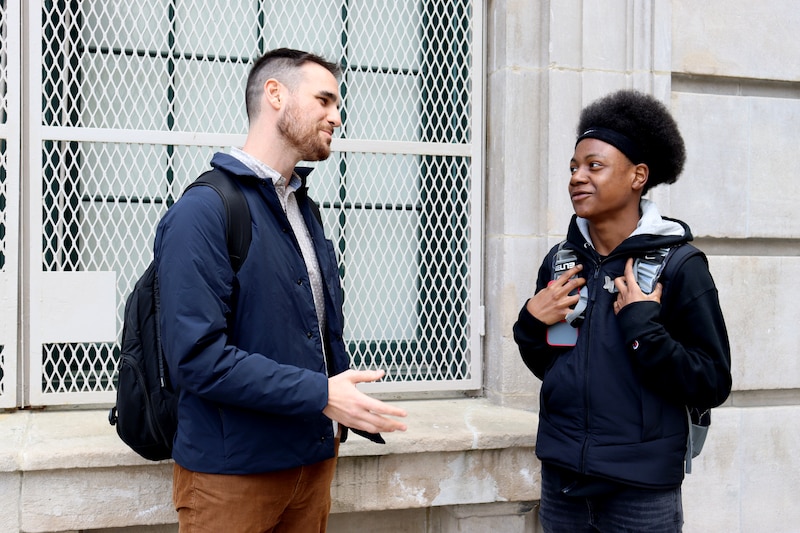When high school teacher Rachel King welcomed a new cohort of 10th graders to her classroom in the fall of 2021, she made a discovery: a number of her students had never completed their coursework from the previous year.
At the time, the 36-year-old taught English at The Urban Assembly Institute of Math and Science for Young Women in downtown Brooklyn. It was her 13th year teaching and her third at the all-girls middle and high school, which serves predominantly Black and Latino children from low-income households.
When schools first shifted to remote learning in March 2020, it quickly became clear that students were struggling to log on to their classes and complete assignments. Thousands lacked access to devices, WiFi, or a quiet place to work. As worry spread that many could get left behind, education department officials announced new academic guidelines. Attendance and testing requirements would be waived for the remainder of the year. No student would fail a course.
If a high schooler was not on track to pass a course by the end of a marking period, they would receive a grade of “NX”— equivalent to a “course in progress”— on their transcripts rather than an “F.” The NX would serve as a placeholder, giving them additional time to make up missing assignments and demonstrate mastery of the course material. In the meantime, they would progress to the next semester or grade. Once they completed missing work, their NX would be retroactively converted into a passing grade.
The education department promised that this would provide greater flexibility and extend empathy to students who were struggling in the face of a major public health crisis.
Reflecting back on the policy, many educators worry it misleadingly inflated graduation rates and left some kids academically unprepared. Many teachers felt their hands were tied and that the system — which they were a part of — failed to support the most vulnerable students.
King initially felt torn about the policy. She wanted to give her students every possible chance to succeed. But she was nervous it would give students a reason not to turn in their work.
In June of 2020, almost 30% of all New York City high schoolers had received an NX in at least one class, according to previously unreported Department of Education data obtained by Chalkbeat and the Toni Stabile Center for Investigative Journalism. With the city’s problematic rollout of its remote summer school program — where a large swath of students never logged on at all — only 3.6% of NXs were converted into passing grades citywide.
According to King, though, her school had successfully supported students through the summer. So that first year most— if not all—of her students were able to clear their NXs.
But as the policy was extended through June of 2021, what was supposed to be a temporary fix eventually became a problematic fixture.
So in the fall of 2021, King and many other teachers greeted thousands of students who had yet to pass their previous year’s classes.
By the end of that school year, at least 95,000 high schoolers across the city – just over 33% – had received at least one NX, according to data received through a Freedom of Information Act request. Disproportionately these were students of color, students in temporary housing, and students with disabilities. About 40% of all Black and Latino high schoolers received at least one incomplete, a rate about twice as high as white students. And almost half of all students with disabilities did not pass at least one class.
Of roughly two dozen teachers across 17 schools in all five boroughs surveyed by Chalkbeat/Toni Stabile Center for Investigative Journalism, the majority said that the work required to convert NXs into passing credits was often minimal and low in rigor. Support from the education department never came, many educators said.
Ultimately, many of the city’s most vulnerable students were pushed through to the next grade level with few supports, no direct instruction, and little work completed, according to the teachers who were surveyed.
A number of teachers said the NX policy preserved the perception that students were doing okay academically. For instance, while graduation rates across the country generally stagnated between 2019 and 2021, New York City’s improved by six points. For students with disabilities, the rate jumped even more: just over nine points.
Yet, as New York City’s graduation rates climbed, so too did the rate of chronic absenteeism. In the 2020-21 school year, nearly 33% of students missed 10% or more school days. Typically, chronic absenteeism is a predictor of poor academic performance since missed school means missed learning time.
Nathaniel Styer, education department spokesperson, said that students still had to meet state graduation requirements. “The NX grades had nothing to do with graduation rates,” he said.
But changes to those requirements gave the NX policy more power.
Pre-pandemic, high school students in New York State had to pass four required exams and accumulate 22 units of academic credit to receive a Regents diploma. During the pandemic, these statewide requirements were loosened with the temporary lifting of Regents testing. Instead, students just needed a passing grade in the course that would have culminated in a Regents. With the NX policy, New York City made it easier to accumulate credits and graduate. While graduation rates across the state climbed, the city’s did so at a faster rate.
“They lowered an already low bar,” said David Bloomfield, an education professor at Brooklyn College and the CUNY Graduate Center.
Bloomfield acknowledged that students needed flexibility during a time when families’ lives were in upheaval. But he said the city’s actions were tantamount to “turning its back on all of these students and saying ‘We’ve got too much to handle during this pandemic. We’re just going to put our heads down on the desk and wave our arms forward for you to just get through.’”
Teachers felt pressure to keep passing rates up
The NX, or “course in progress,” policy was not new, even though few teachers had ever heard of it. It was intended to be for a small population of students experiencing an acute crisis, such as a health emergency. The education department expanded its use to unprecedented levels during the pandemic.
Suddenly, many teachers were responsible not only for their new course loads, but also for all of the students who had not passed the previous year. Students, too, were responsible for their current course loads while also trying to make up past work.
Education department officials had pledged to provide schools with the resources necessary to support students through this unprecedented time, such as staffing and devices. Of the 25 teachers surveyed, only three were aware of support provided to their school regarding implementation of the NX policy, other than electronics.
Officials did not respond to questions regarding what support the education department had provided to schools. They did not answer questions about what was required of students to recover these credits.
The majority of teachers surveyed said their students only had to complete independent work, such as packets or brief online assignments, in order to pass. A few teachers said they did not know what work was assigned to their students who did not pass courses; once they assigned the NX they never received updates about their students’ progress.
Over half of the respondents reported that the students who received NXs did not receive direct instruction from a teacher or complete meaningful work in order to receive their credits.
It appears that once a student with an NX completed the work necessary to pass the course, any record of that NX was cleared from the transcript, making it difficult for future teachers or professors to know which students might need additional support.
Some teachers described tacit pressure from school administrators to keep their passing rates up, despite the lack of completed work. One Brooklyn science teacher alleged that his principal explicitly told staff to pass all middle schoolers outright, discouraging them from giving out NXs in the first place, even if the students had never attended class.
A number of teachers also reported that, while they did not like the policy outcomes, they were not sure what other options existed for the city. One administrator said that the city provided him with policy updates, superintendent check-ins, and support with use of resources that students and teachers could use to make up work. His school relied largely on an online learning platform to recover credits.
A Staten Island history teacher reported that her department was asked to create a packet of work for all high school students with NXs. Once these packets were distributed, she never saw them again. Students were asked, instead, to give them to the school administrators. They then graded the students’ work, rather than returning it to the teachers. Administrators either instructed teachers to change the NXs to a passing grade or went into grade books and did so themselves.
Many teachers acknowledged lowering their own expectations, feeling like they had no other choice given the circumstances. More than 8,700 New York City children lost a parent or caregiver to the coronavirus, according to the COVID Collective.
A high school history teacher in Queens said that when she gave her students NX grades they returned to her for an additional class the next year. But the coursework this time, she said, was “a joke.” Because the course asked for no student-teacher engagement, she said she never even met some of her students.
“They didn’t come to class. I could bump into them on the street. Unless you told me their name I wouldn’t know them,” she said.
Despite her discomfort with the policy, she said it did work for some students who really struggled. The “course in progress” work allowed the students to move on and gave them a chance to finish high school, even if the work was not comparable to a real course.
Will Ehrenfeld, a high school history teacher at P-Tech, in Crown Heights, Brooklyn, serving predominantly students from low-income backgrounds, said that by the spring of 2021, in a class of 30, only two or three students typically attended live Zoom sessions.
More than a quarter of his students received an NX, he said. Ehrenfeld put a lot of pressure on himself to help kids pass to the next grade level. He wanted them to get the chance to move forward with their lives.
“I don’t want to hold kids back,” Ehrenfeld said, “but I do think it’s worth learning history and learning how to write… A lot of our kids went off to college and really struggled.”

Even with the flexibility of the NX policy, more than 1 in 5 high school students did not reconcile their NXs from June 2021 to passing marks.
When asked about what happened to these 61,000 students who failed to convert their NX into a passing grade, an education department spokesperson said, “They might have just taken the ‘F’ and moved forward.” (Not all courses are required for graduation.)
King, the teacher at the Institute of Math and Science, became increasingly frustrated as the year wore on, and she watched the requirements for her students continue to plummet. The city’s expectations fell first, then her school’s, and finally her own, she said.
King said at one point she was told by her school’s administration to use students’ grades on a single assignment as their grade for the entire year. Students quickly caught on. “They knew if they just turned something in, they would pass.” King had six students who never showed up and never completed make-up work. They still passed, she said.
For the first time in her 13-year career, she began toying with the idea of leaving. “I can say this isn’t good for kids one thousand times and nobody is going to care,” she said.
Some students benefited from grading policy, others struggled
Kenneth Johnson, a high school senior at P-Tech, was a strong student before schools were shuttered in the spring of 2020.
He successfully balanced his course load and his love for track and football. His favorite class was math. After the transition to remote learning, he struggled to keep up. He finished out the year with multiple NXs.

In the fall of 2020, Johnson moved to New Jersey to live with his father and play football at the local high school. Because the NX policy did not exist there, he was unable to recover his missing credits. After moving back, he returned to P-Tech. “That’s where the NX portion came in,” he said. “It really helped me to get back on track.”
He said the work he completed was not equivalent to an entire year’s worth of course material, but it was still challenging. “You had to be on point with it, still like a regular class,” he said. “It was a cool concept. Allowing the kids who didn’t take the remote [learning] as seriously as they should have to redeem themself.”
Earlier this year, Johnson enlisted in the Army. Because of test scores, he qualified for a math-based job, and was able to move up a rank.
For other students, though, it was more detrimental.
TJ Kor had a number of NXs by fall of 2020 when he was a sophomore at William Cullen Bryant High School in Queens. While the make-up work was not rigorous, it required his attention on the weekends and after school. He became overwhelmed.
Kor was so behind from all of the missed instruction, he would benefit from repeating the entire grade, his mother argued. The school disagreed, which frustrated his mother, Helen Kor. She wondered, does an NX really satisfy the needs of students? The school told her that when students are forced to repeat grades they suffer, she said. Some studies support that idea.
Kor’s mother eventually transferred him to an independent school for his junior year. “He recognizes he’s not alone. There’s lots of people who are trying to make up the credits they lost during the pandemic.”
For one teacher, the final straw
From the start, the 2021-22 school year was atypical for King. One of her normal teaching duties had been replaced with a course exclusively for students who had received an NX the previous spring. She was on the books as their teacher of record, but she had never met a number of them. “I didn’t know what they looked like, what they sounded like, had not seen any work from them. Nothing. The NXs were truly the ones who were like, I forgot this person was on my roll.”
King struggled to get her students to show up for the first period make-up course. She created assignments, such as paragraphs analyzing TedTalks, that students could do independently. She sent them end-of-unit projects from the year before and asked them to at least complete those. Some did, others did not. As time went on, the tacit pressure to pass them mounted.
Her regular classes felt more challenging too. “I had 10th graders who could not, in an entire hour, produce four to six sentences.”
Then, one morning while biking to school, King was hit by a car. For the many days she could not be in school because of her injuries, another teacher covered her NX course. Her students continued to miss the class. As time went on, she felt that if she did not pass them, the next teacher would. The entire operation was built to fail, she said.
By winter break, King thought, “I don’t know how much longer I can put up with this.” And that, she said, was when she cleared her NXs and passed all of her students. The move felt unethical, but she was defeated and unsure of what other option she had.
Looking back, King felt empathy for the decision makers, for the city, for those who were making policy choices throughout the pandemic. She recognized what a difficult time this was, filled with confusion and uncertainty. But, it also exposed the deeper systemic fissures that had gone unchecked for so many years. For her, it was the final straw.
By March 2022, she had quit.
Amanda Geduld reported this story as a Stabile Investigative Fellow while at Columbia’s Journalism School. She was previously an English teacher in New York City.


